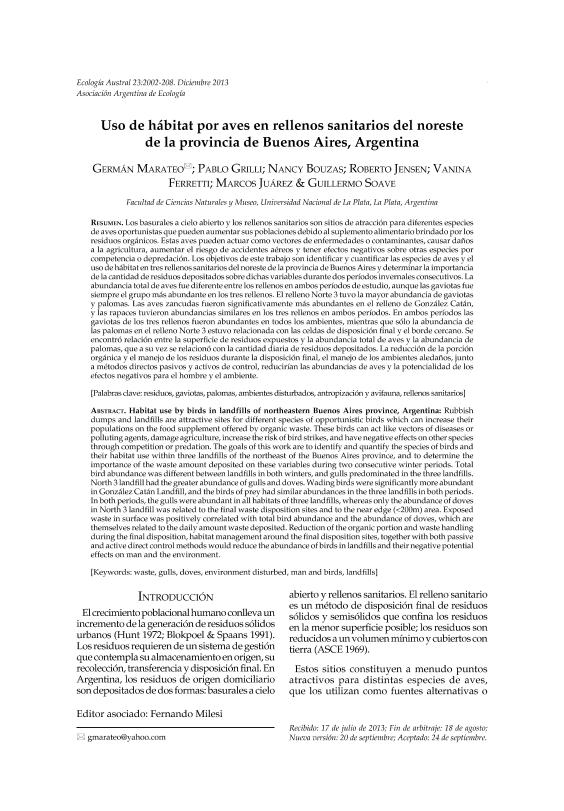Artículo
Los basurales a cielo abierto y los rellenos sanitarios son sitios de atracción para diferentes especies de aves oportunistas que pueden aumentar sus poblaciones debido al suplemento alimentario brindado por los residuos orgánicos. Estas aves pueden actuar como vectores de enfermedades o contaminantes, causar daños a la agricultura, aumentar el riesgo de accidentes aéreos y tener efectos negativos sobre otras especies por competencia o depredación. Los objetivos de este trabajo son identificar y cuantificar las especies de aves y el uso de hábitat en tres rellenos sanitarios del noreste de la provincia de Buenos Aires y determinar la importancia de la cantidad de residuos depositados sobre dichas variables durante dos períodos invernales consecutivos. La abundancia total de aves fue diferente entre los rellenos en ambos períodos de estudio, aunque las gaviotas fue siempre el grupo más abundante en los tres rellenos. El relleno Norte 3 tuvo la mayor abundancia de gaviotas y palomas. Las aves zancudas fueron significativamente más abundantes en el relleno de González Catán, y las rapaces tuvieron abundancias similares en los tres rellenos en ambos períodos. En ambos períodos las gaviotas de los tres rellenos fueron abundantes en todos los ambientes, mientras que sólo la abundancia de las palomas en el relleno Norte 3 estuvo relacionada con las celdas de disposición final y el borde cercano. Se encontró relación entre la superficie de residuos expuestos y la abundancia total de aves y la abundancia de palomas, que a su vez se relacionó con la cantidad diaria de residuos depositados. La reducción de la porción orgánica y el manejo de los residuos durante la disposición final, el manejo de los ambientes aledaños, junto a métodos directos pasivos y activos de control, reducirían las abundancias de aves y la potencialidad de los efectos negativos para el hombre y el ambiente. Rubbish dumps and landfills are attractive sites for different species of opportunistic birds which can increase their populations on the food supplement offered by organic waste. These birds can act like vectors of diseases or polluting agents, damage agriculture, increase the risk of bird strikes, and have negative effects on other species through competition or predation. The goals of this work are to identify and quantify the species of birds and their habitat use within three landfills of the northeast of the Buenos Aires province, and to determine the importance of the waste amount deposited on these variables during two consecutive winter periods. Total bird abundance was different between landfills in both winters, and gulls predominated in the three landfills. North 3 landfill had the greater abundance of gulls and doves. Wading birds were significantly more abundant in González Catán Landfills, and the birds of prey had similar abundances in the three landfills in both periods. In both periods, the gulls were abundant in all habitats of three landfills, whereas only the abundance of doves in North 3 landfills was related to the final waste disposition sites and to the near edge (<200m) area. Exposed waste in surface was positively correlated with total bird abundance and the abundance of doves, which are themselves related to the daily amount waste deposited. Reduction of the organic portion and waste handling during the final disposition, habitat management around the final disposition sites, together with both passive and active direct control methods would reduce the abundance of birds in landfills and their negative potential effects on man and the environment.
Uso de hábitat por aves en rellenos sanitarios del noreste de la provincia de Buenos Aires, Argentina
Título:
Habitat use by birds in landfills of northeastern Buenos Aires province, Argentina
Marateo, Germán; Grilli, Pablo Gervasio; Bouzas, Nancy; Jensen, Roberto Francisco ; Ferretti, Vanina; Juárez, Marcos; Soave, Guillermo
; Ferretti, Vanina; Juárez, Marcos; Soave, Guillermo
 ; Ferretti, Vanina; Juárez, Marcos; Soave, Guillermo
; Ferretti, Vanina; Juárez, Marcos; Soave, Guillermo
Fecha de publicación:
12/2013
Editorial:
Asociación Argentina de Ecología
Revista:
Ecología Austral
ISSN:
0327-5477
Idioma:
Español
Tipo de recurso:
Artículo publicado
Clasificación temática:
Resumen
Archivos asociados
Licencia
Identificadores
Colecciones
Articulos(ILPLA)
Articulos de INST.DE LIMNOLOGIA "DR. RAUL A. RINGUELET"
Articulos de INST.DE LIMNOLOGIA "DR. RAUL A. RINGUELET"
Citación
Marateo, Germán; Grilli, Pablo Gervasio; Bouzas, Nancy; Jensen, Roberto Francisco; Ferretti, Vanina; et al.; Uso de hábitat por aves en rellenos sanitarios del noreste de la provincia de Buenos Aires, Argentina; Asociación Argentina de Ecología; Ecología Austral; 23; 3; 12-2013; 203-208
Compartir



